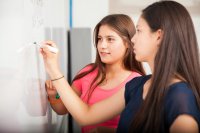5 Tips for Improving Students’ Success in Math
Teachers who coach teams in a mathematical modeling challenge share ideas for helping students develop more confidence.
What does it take to improve student success and interest in math? The Philadelphia-based Society for Industrial and Applied Mathematics (SIAM) asked more than 400 U.S. high school math teachers for their advice related to teaching and learning mathematics.
“The good news is that students can have success in math class with the right effort, attitude, and behavior, regardless of a natural affinity or being ‘good at math,’” said Michelle Montgomery, project director of the MathWorks Math Modeling (M3) Challenge at SIAM. “Using quantitative skills to solve real, open-ended problems by employing the mathematical modeling process is a great way to get started.”
The teachers surveyed were all coaches of student teams that participated in the M3 Challenge, a national, internet-based contest with no registration or participation fees. Thousands of high school juniors and seniors spend a weekend in March coming up with a solution to a real-world problem using mathematical modeling. To add a bit of pressure, when the students download the problem, they have only 14 hours to work on it. The 2018 event was the 13th annual contest.
What the Teachers Recommend
1. Build confidence. More than two-thirds of respondents (68 percent) cited lack of confidence as a problem that prevents their students from succeeding in mathematics.
2. Encourage questioning and make space for curiosity. Sixty-six percent of respondents said their best piece of advice for students looking to do well in math was to not only pay attention in class but also ask for clarification when they need to better understand something.
3. Emphasize conceptual understanding over procedure. Three out of four respondents (75 percent) emphasized that working hard to understand math concepts and when to apply them versus simply memorizing formulas is essential to doing well.
4. Provide authentic problems that increase students’ drive to engage with math. Sixty-three percent of participants pointed to students’ desire, initiative, and motivation to succeed in math as being critical, and the majority of them (80 percent) said that applying math to real-world problems helps increase both student interest and understanding.
5. Share positive attitudes about math. Teachers suggest that parents avoid talking negatively about math, and especially avoid saying that it is hard or useless (74 percent)—instead they should encourage their kids not to give up, and help them find math mentors when they’re not able to answer questions (71 percent).
It’s no coincidence that these teaching practices are a regular part of facilitating math modeling. Through modeling, students tackle relevant, authentic, real-world problems. According to Lauren Tabolinsky, academic program manager at MathWorks, making math relevant for students and careers is the reason MathWorks sponsors the M3 Challenge.
SIAM’s Montgomery adds that “inherent in modeling work are things like motivation, identification of variables that affect the issue (no spoon feeding of data or approaches), gut checking of answers, and justifying solutions offered. The result? Interest and enthusiasm for working a problem, and the understanding that being able to use skills in your math toolbox can provide insight into relevant issues facing communities and the world today.”
For example, the 2018 M3 Challenge problem was called “Better ate than never: Reducing wasted food.” Students addressed an issue identified by the Food and Agriculture Organization of the United Nations: Approximately one-third of all food produced in the world for human consumption every year goes uneaten.
In the first part of the problem, student teams used mathematics to predict whether the food waste in a given state could feed all of the food-insecure people living there. In the second part, teams created a mathematical model that could be used to determine the amount of food waste a household generates in a year based on their traits and habits. They were given four different types of households to consider.
Finally the teams were challenged to make suggestions about how wasted food might be repurposed. They used mathematical modeling to provide insight into which strategies should be adopted to repurpose the maximal amount of food at the minimum cost, and they accounted for the costs and benefits associated with their strategies.
Because such problems are realistic, big, and messy, student teams have plenty of opportunity to make genuine choices about how they want to go about solving them, which mathematical tools they will apply to develop and test their models, and how they will communicate their solution. There’s plenty of work to go around, so all team members can contribute.
If you relate this M3 Challenge modeling problem to the advice from the teacher coaches above, you can see why participation in math modeling competitions as a team sport can help students develop more mathematical confidence, competence, and interest.
